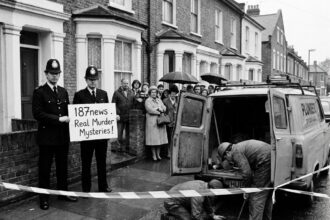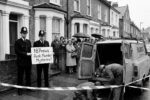Glasgow remains Scotland’s most dangerous city, where the murderer Susan Newell once wreaked havoc. She was the last woman in Scotland to be hanged as punishment in the courtyard of Duke Street Prison, Glasgow’s women’s prison. Today, the Cathedral House Hotel stands on the site where Susan Newell’s ghost still keeps hotel guests awake at night. But who did Susan Newell murder? Susan was born Susan McAllister in Glasgow in 1893. She grew up in poverty. Her first husband, with whom she had a daughter named Janet, died in World War I. In 1923, Susan married subway worker John Newell, a womanizer and drunkard. They lived with their 8-year-old daughter Janet in a rented apartment on Newlands Street in the Glasgow suburb of Coatbridge. There were frequent arguments between the couple, which ended with their landlady, Mrs. Young, terminating their lease. After that, the dispute escalated completely and Susan attacked John, causing him serious head injuries on June 19, 1923. He then informed the police and fled to his sister’s house. The next evening, around 6:45 p.m., 13-year-old newspaper boy John Johnston knocked on Susan’s door to sell her an evening paper. Susan invited the boy in and took a newspaper from him. When he asked for the money for the newspaper, Susan simply refused to pay. An argument ensued, which ended with Susan strangling the boy. After Susan’s daughter Janet returned home from playing, she helped her mother wrap the boy’s body in a carpet. The next day, the mother-daughter duo loaded the tied-up bundle onto a go-kart. They wanted to use it to transport the body from Coatbridge to Glasgow. On the way there, a truck driver stopped and gave them a ride to Duke Street in Glasgow. When he unloaded the go-kart with the bundle, a resident of the street saw a foot sticking out. However, the truck driver did not notice anything. The woman decided to follow the mother-daughter duo together with her sister. On the way, they met a man who was supposed to alert the police. When the mother and daughter tried to dispose of the body in a backyard and then flee over the wall, they were arrested by the police. During police questioning, the mother-daughter duo accused John of killing the paperboy and forcing them to dispose of the body. On September 18, 1923, Susan and John Newell were tried for the murder of John Johnston before Lord Alness. Since John had a watertight alibi, as he was at his brother’s funeral at the time of the crime, the charges against John Newell were dropped. The autopsy of John Johnston’s body revealed that he had been strangled so brutally that his windpipe had burst. In addition, part of his skull had collapsed due to the blows he had received. Susan’s lawyer attempted to build her defense on the grounds that she was of unsound mind, which was refuted by the prosecution’s expert witness, Professor John Glaister. Susan Newell was found guilty by the jury of the murder of John Johnston, which was known to the public only as the “Go-Kart Tragedy” and the “Coatbridge Murder.” Susann was sentenced to death by hanging. Susann then submitted a petition to the Scottish Secretary of State to commute the death penalty to a prison sentence. However, this was rejected. On October 10, 1923, 30-year-old Susan Newell was executed at Duke Street Prison in Glasgow, where her ghost is said to roam at night to this day.
Murder in Scotland’s most dangerous city

Tagged:AileenWuornosAktuellesAlpenMysteryAngriffAntiterrorAttentateAutoeinbruchBankenVerbrechenCHBaslerBluttatenBayernKrimiBeklemmendSpannendBerichterstattungBernerMysterienBerühmteFälleDeutschlandBerühmteKriminalfälleBetrugBeweisaufnahmeBjarneMädelBlackDahliaBostonStranglerBRDVerbrechenBreakingNewsBrigitteHeikeBrunoLüdkeCelebrityCrimeCharlesMansonColdCaseColdCaseGermanyColdCasesColdCasesÖsterreichCommunityCrimeSolversCrimeDokuSchweizCrimeNeverSleepsCrimeSceneInvestigationCrimeSolveAttemptCyberCrimeDarknetDatenklauDatenschutzverletzungDDRVerbrechenDerMannimEisDetectiveWorkDetektivarbeitDetektivgeschichteDeutscheGeschichteDeutscheKriminalfälleDeutscherMordfallDiebstahlDigitalDetectivesDNAEvidenceDNARevolutionDrogenhandelnDrogenkartellDrogenkonsumDrogenmissbrauchDrogenschmuggelEchteVerbrechenEdGeinEinbruchEmdenMissbrauchsfallErmittlungenErmittlungsarbeitErmordetEvidentialBreakthroughExtremismusFacebookInvestigatorsFahndungFalcoMordtheorieFamiliendramaCHFanTreffenFemaleCriminalsFinanzbetrugFinanzverbrechenForensicScienceForensikForensikÖsterreichForensischeWissenschaftenFritzHaarmannGefährlicheDamenGefährlicheGifteGeheimnisseDerAlpenGeheimnisvolleVergiftungGeldwäscheGenferKriminalfälleGerechtigkeitGerichtsdramaSchweizGerichtsverfahrenGeschichtsverbrechenGesetzlosigkeitGewaltverbrechenGifteInDerKunstGiftigeRezepturenGiftMordGiftmordGeschichteGladbeckerGeiseldramaGlobalColdCasesGruseligeVerbrechenGruselnMitUnsHackingHamburgTrueCrimeHäuslicheGewaltHerculePoirotHinterkaifeckMordeHistoricalCrimeHistorischeVerbrechenHistorischeVerbrechenCHHistoryLover PastMysteriesIdentitätsdiebstahlInternetbetrugJackTheRipperJackUnterwegerJohnWayneGacyJonBenetRamseyJosefFritzlJugendverbrechenJürgenBartschJustizdramaJustizirrtümerJustizsystemKalteFälleDeutschlandKinderhandelKommissarBeckKommissarDupinKommissarMaigretKommissarWallanderKörperverletzungKreditkartenbetrugKrimiAutorenKrimiBuchKrimiDeutschlandKrimiDokumentationKrimiLiteraturKriminalfälleKriminalgeschichtenKriminalgeschichteÖsterreichKriminalitätNRWKriminalitätsgeschichteKriminalnachrichtenKriminalpolizeiKriminalpräventionKriminalpsychologieKriminalstatistikKriminelleAlchemieKriminologieKrimiPodcastsKrimiSchwarzwaldKrimiSerienKultkriminalfälleKunstraubLebachFallLiveBerichterstattungCHLocalColdCasesMagdaGoebbelsMysteryManfredScharfenorthMenschenhandelMilieuStudienMissbrauchMissingAustriaMissMarpleMittelalterlicheVerbrechenModerneGifteModerneSklavereiModernToxinMordMordfälleMordlustMordundTotschlagMünchenMordMysteriöseFälleMysteriöseTodeMysteriousCaseMysteryInTheUSAMysteryLoverMysteryLoversAustriaNataschaKampuschNaturschutzdeliktNeuesNordicNoirNSUProzessOldCaseNewEvidenceOnlineBetrugOnlineSleuthingOpferhilfeOpferschutzOpferUndTäterOrganisierteKriminalitätÖsterreichMythenPeterKürtenPhilipMarlowePhishingPlünderungPodcastJunkiePolitThrillerSchweizPolizeieinsatzPolizeiruf110ProfilerÖsterreichProfilingPromiSkandalePsychologieDerVerbrechenPsychothrillerRadikalisierungRansomwareRateMitRaubRaubüberfallRauschgiftRechtsmedizinRedditDetectivesRichardRamirezSagenUndMärchenSchuldUndSühneSchweizerKriminalfälleSerienmörderSexhandelSherlockHolmesSicherLebenSpannungPurSpurensucheStarVerbrechenSteirischeVerbrechenStrafrechtSuchtTaschendiebstahlTäterprofileTatortTatortBerlinTatortBremenTatortDeutschlandTatortDortmundTatortGiftfläschchenTatortHistorieTatortKlassikerTatortKölnTatortKommissarTatortKrimiTatortMünchenTatortMünsterTatortsonntagTatortSpekulationenTatortStuttgartTatortuntersuchungTatortWeimarTatortWienTatortZeitTedBundyTerroranschlagTerrorismusTheSodderChildrenThrillerThrillerLesenTimeTravelDetectiveTirolerMysterienTödlicheKulisseTotschlagToxischeWahrheitTrueCrimeAddictTrueCrimeAusstellungenTrueCrimeAutorenTrueCrimeBlogsTrueCrimeBücherTrueCrimeCommunityTrueCrimeDeutschlandTrueCrimeDokuTrueCrimeEventsTrueCrimeFandomTrueCrimeGiftTrueCrimeÖsterreichTrueCrimePodcastTrueCrimePodcastsCHTrueCrimeSchweizTrueCrimeSerieTrueCrimeStoriesTrueCrimeYouTubeUmweltverbrechenUmweltverschmutzungUngeklärteFälleUngeklärteFälleSchweizUnsolvedEuropeUnsolvedMysteryUnterschätztesGiftUrbanLegendsAustriaVandalismusVerboteneLiebeVerbrechenVerbrechenDerMächtigenVerbrechenIm19JahrhundertVerbrechenInBerlinVerbrecheninDeutschlandVerbrechenInWienVerbrechenUndStrafeVerbrechenVonNebenanVerbrecherjagdVergewaltigungVergifteteLiebeVermisstenfälleVersicherungsbetrugVerurteiltDerPodcastVintageCrimeVorsichtGiftWahreVerbrechenWaldbrandstiftungWarumMenschenTötenWildereiWirtschaftskriminalitätZeitVerbrechenZodiacKillerZürcherKrimiZwangsarbeit







